1994 CHEVROLET SUBURBAN inflation pressure
[x] Cancel search: inflation pressurePage 247 of 385
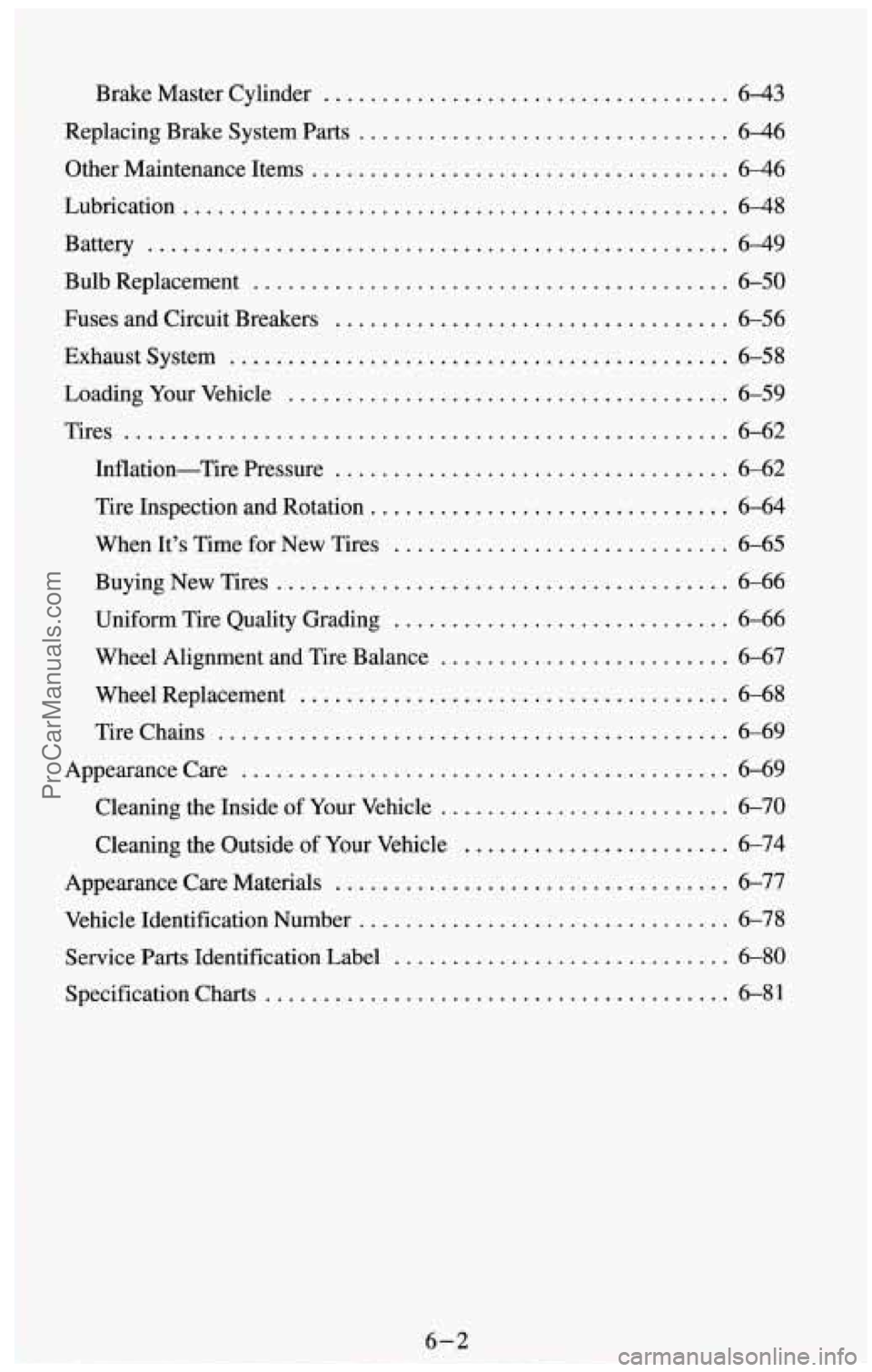
......................
................
Brake Master Cylinder ................................... 6-43
Replacing Brake System Parts .............................. 6-46
Other Maintenance Items .................................... 646
Lubrication ............. ..... 648
Battery ................ ....... 6-49
Bulb Replacement ......................................... 6-50
Fuses and Circuit Breakers ................................ 6-56
Exhaust System ....................................... 6-58
Loading Your Vehicle ...................................... 6-59
Tires .................................................... 6-62
Inflation-Tire Pressure .................................. 6-62
Tire Inspection and Rotation ............................... 6-64
When It’s Time for New Tires ......................... 6-65
Buying New Tires ..................................... 6-66
Uniform Tire Quality Grading ............................. 6-66
Wheel Alignment and Tire Balance ......................... 6-67
Wheel Replacement ..................................... 6-68
Tire Chains ............................................ 6-69
Appearancecare .......................................... 6-69
Cleaning the Inside of Your Vehicle ......................... 6-70
Cleaning the Outside of Your Vehicle ..................... 6-74
Appearance Care Materials .................................. 6-77
Vehicle Identification Number .............................. 6-78
Service Parts Identification Label ............................. 6-80
Specification Charts ...................................... 6-81
6-2
ProCarManuals.com
Page 304 of 385
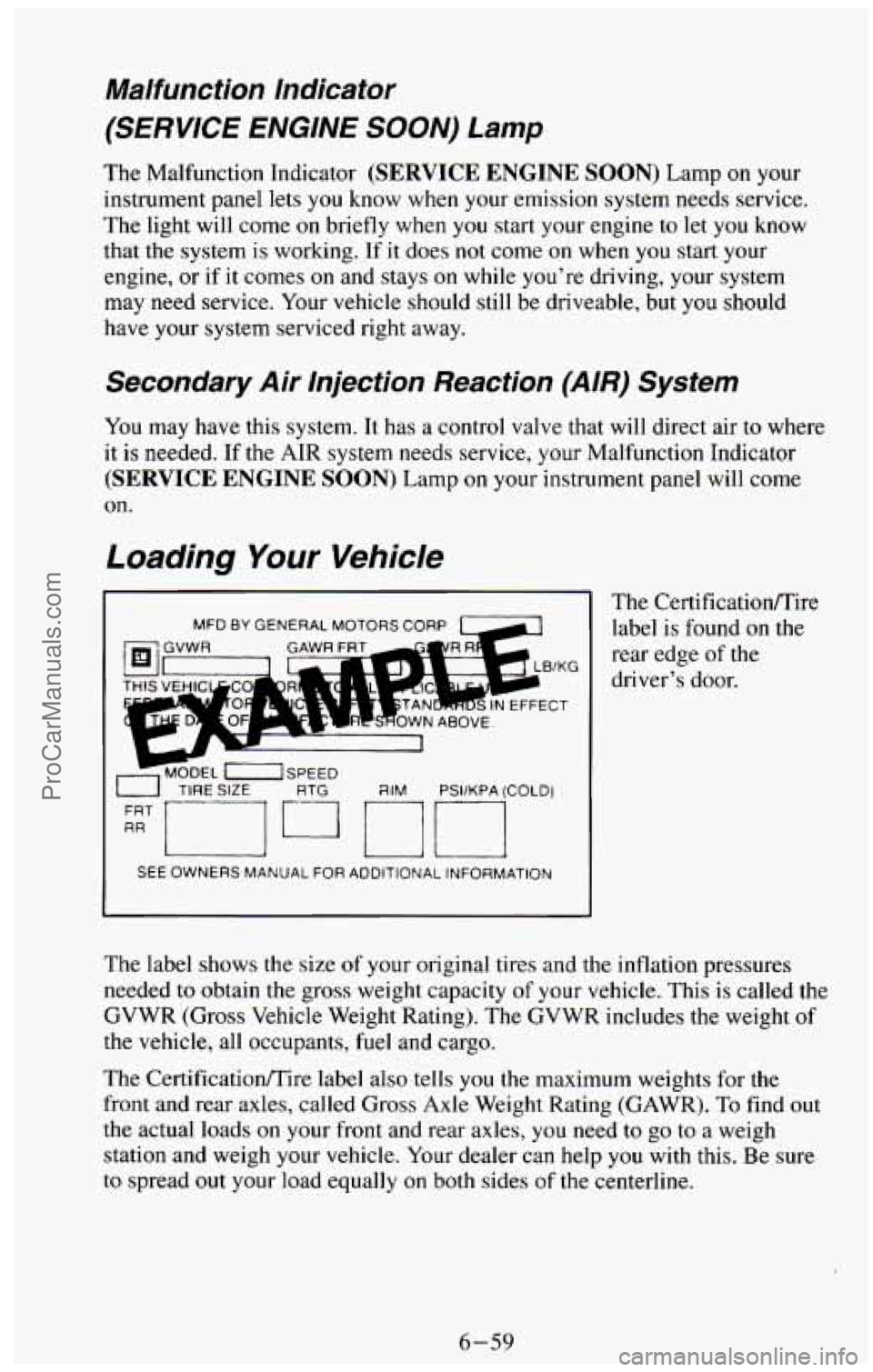
Malfunction Indicator
(SERVICE ENGINE SOON) Lamp
The Malfunction Indicator (SERVICE ENGINE SOON) Lamp on your
instrument panel lets you know when your emission system needs service.
The light
will come on briefly when you start your engine to let you know
that the system is working.
If it does not come on when you start your
engine,
or if it comes on and stays on while you're driving, your system
may need service. Your vehicle should still be driveable, but
you should
have your system serviced right away.
Secondary Air Injection Reaction (AIR) System
You may have this system. It has a control valve that will direct air to where
it is needed. If the AIR system needs service, your Malfunction Indicator
(SERVICE ENGINE SOON) Lamp on your instrument panel will come
on.
Loading Your Vehicle
MFD BY GENERAL MOT0 RSCORP
i IN EFFECT -
I
- MODEL [ISPEED w
u TIRE SIZE RTG FilM PSllKPA (COLD)
q----p nri
SEE OWNERS MANUAL FOR ADDITIONAL INFORMATION
The CertificatiodTire
label is found
on the
rear edge
of the
driver's door.
The label shows the size
of your original tires and the inflation pressures
needed to obtain the gross weight capacity
of your vehicle. This is called the.
GVWR (Gross Vehicle Weight Rating). The GVWR includes the weight
of
the vehicle, all occupants, fuel and cargo.
The Certificatioflire label also tells you the maximum weights for the
front and rear axles, called Gross Axle Weight Rating (GAWR).
To find out
the actual loads on your front and rear axles,
you need to go to a weigh
station and weigh your vehicle. Your dealer can help you with this.
Be sure
to spread out your load equally on both sides of the centerline.
6-59
ProCarManuals.com
Page 307 of 385
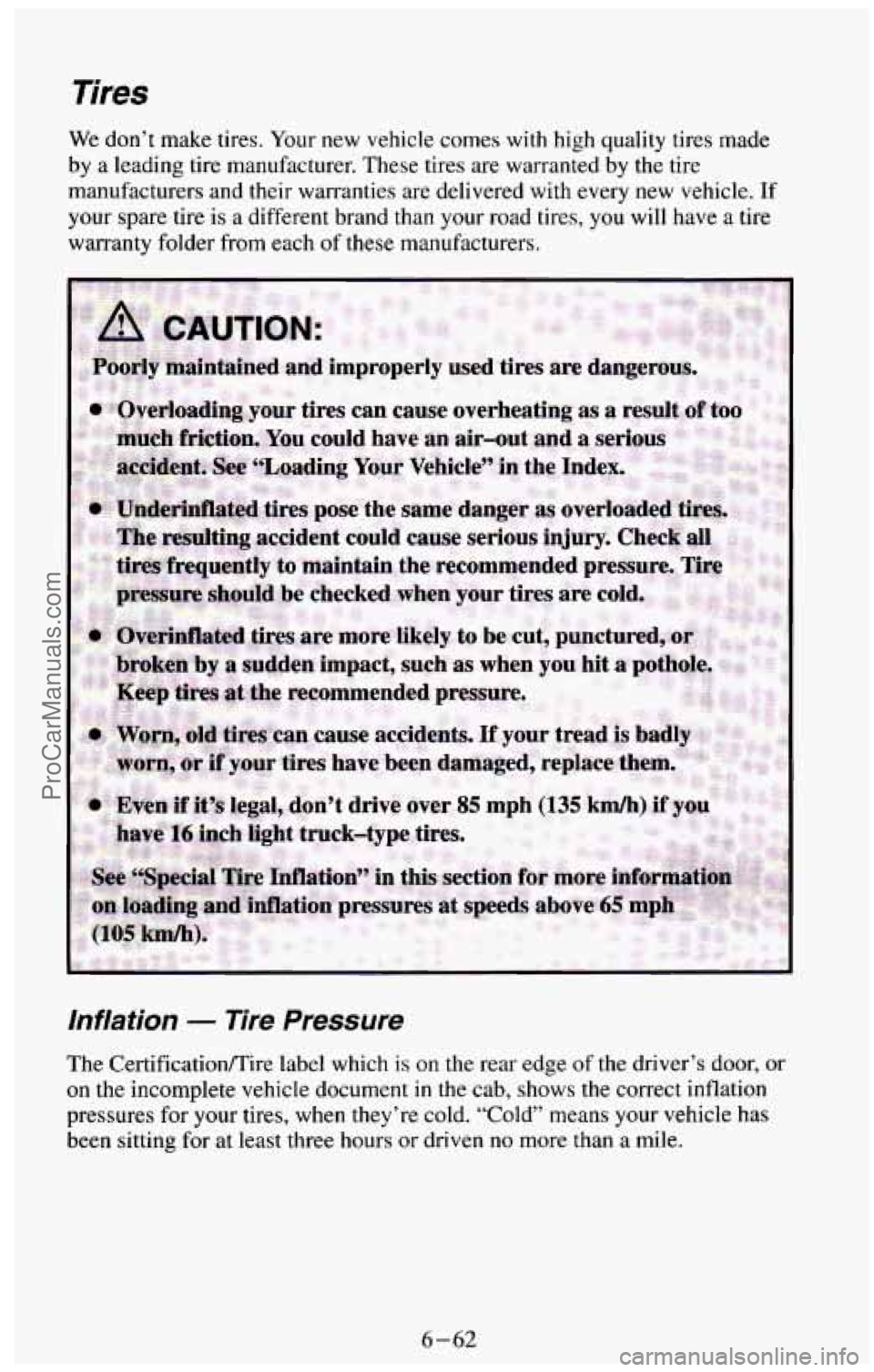
Tires
We don’t make tires. Your new vehicle comes with high quality tires made
by a leading tire manufacturer. These tires are warranted by the tire
manufacturers and their warranties are delivered with every
new vehicle. If
your spare tire is a different brand than your road tires, you will have a tire
warranty folder from each of
these manufacturers.
Inflation - Tire Pressure
The Certification/Tire label which is on the rear edge of the driver’s door, or
on the incomplete vehicle document in the cab, shows the correct inflation
pressures for your tires, when they’re cold.
“Cold” means your vehicle has
been sitting for at least three hours or driven no more than
a mile.
6-62
ProCarManuals.com
Page 308 of 385
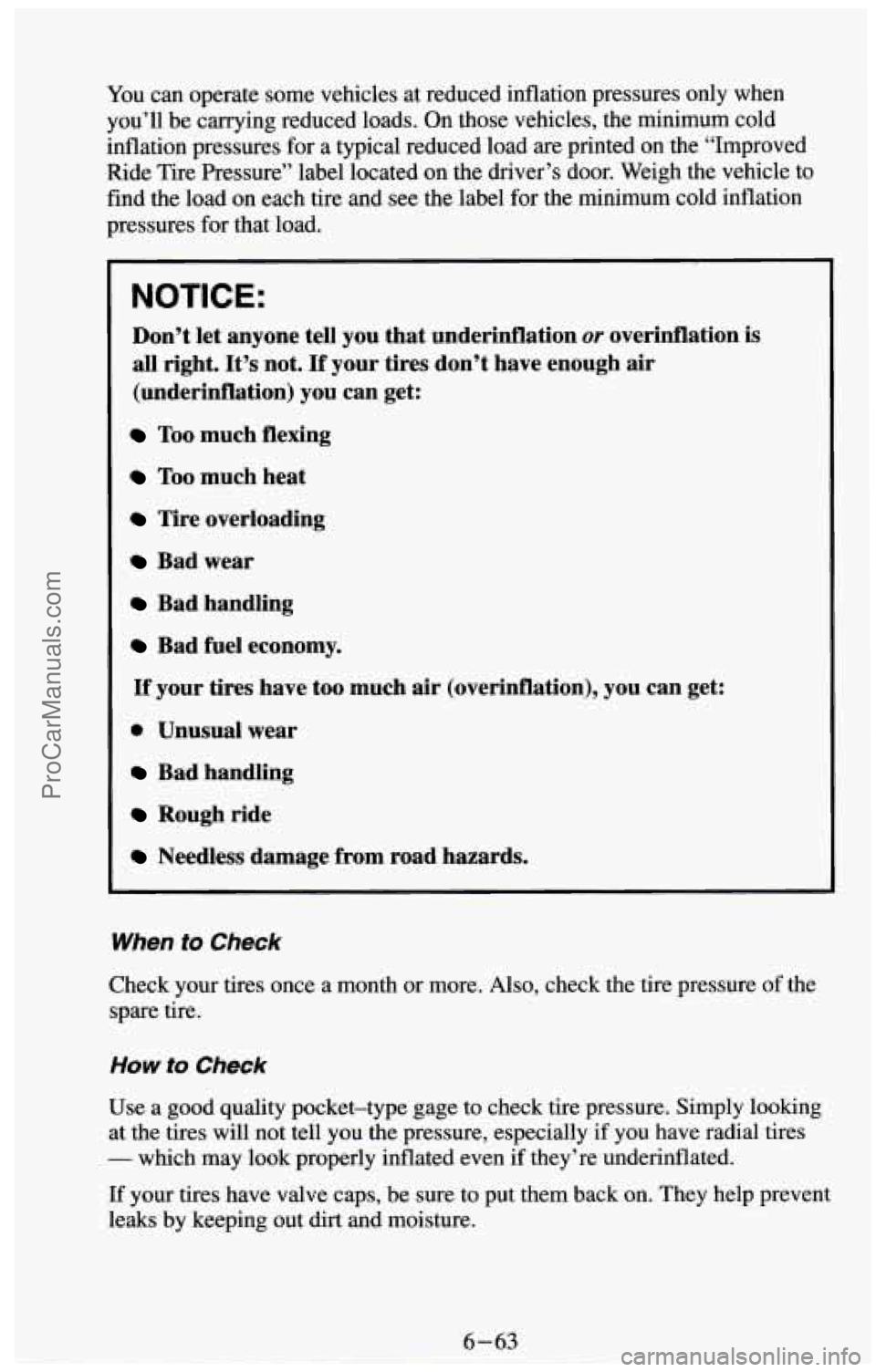
You can operate some vehicles at reduced inflation pressures only when
you’ll be carrying reduced loads. On those vehicles, the minimum cold
inflation pressures for a typical reduced load are printed on the “Improved
Ride Tire Pressure” label located on the driver’s door. Weigh the vehicle to
find the load on each tire and see the label for the minimum cold inflation
pressures for that load.
Don’t let anyone tell you that underinflation or overinflation is
all right.
It’s not. If your tires don’t have enough air
(underinflation) you can get:
Too much flexing
Too much heat
Tire overloading
Bad wear
Bad handling
Bad fuel economy.
If your tires have too much air (overinflation), you can get:
0 Unusual wear
Bad handling
Rough ride
Needless damage from road hazards.
When to Check
Check your tires once a month or more. Also, check the tire pressure of the
spare tire.
How to Check
Use a good quality pocket-type gage to check tire pressure. Simply looking
at the tires will not tell you the pressure, especially
if you have radial tires
- which may look properly inflated even if they’re underinflated.
If your tires have valve caps, be sure to put them back on. They help prevent
leaks by keeping out dirt and moisture.
ProCarManuals.com
Page 309 of 385
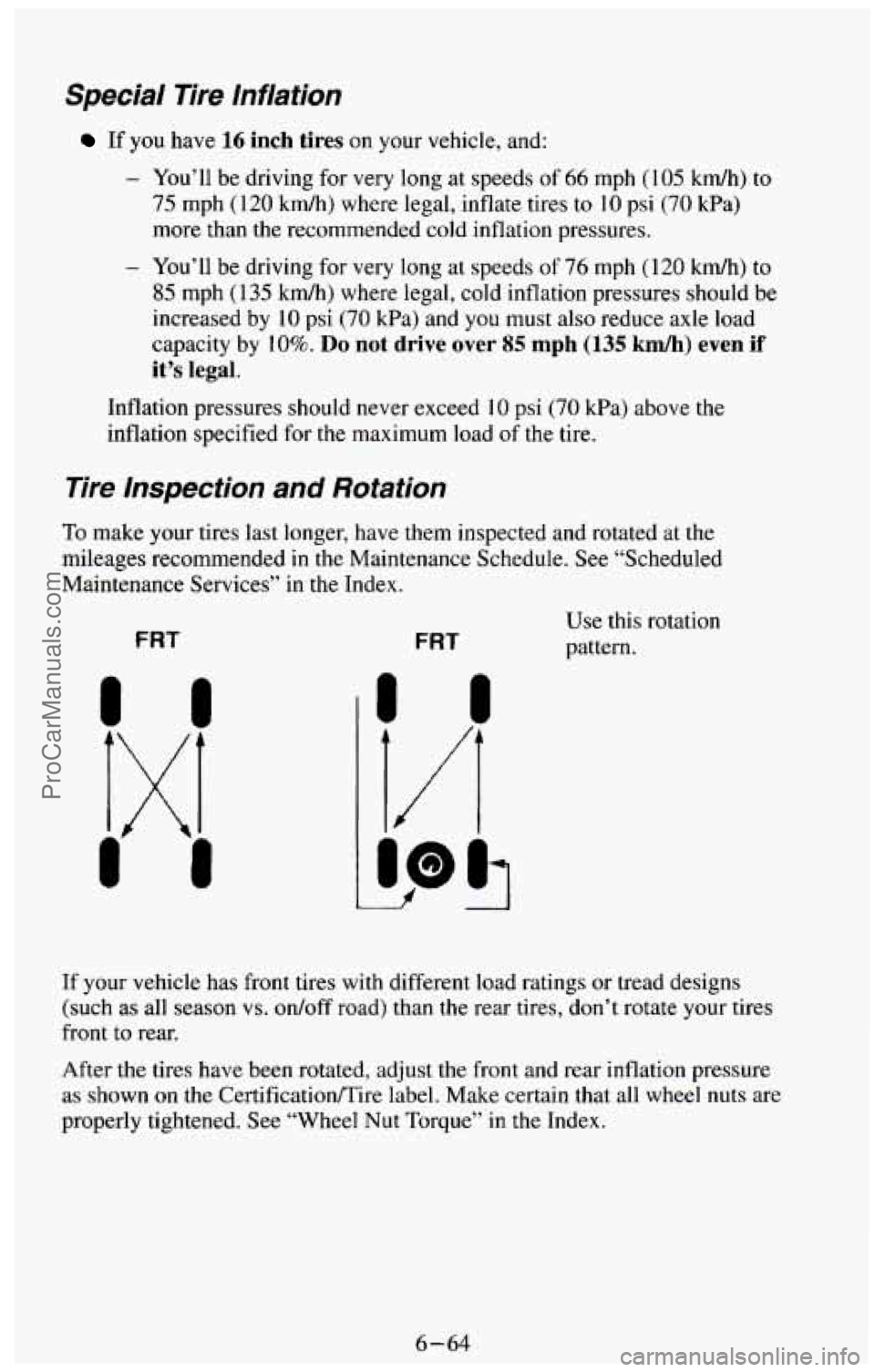
Special Tire lnflation
If you have 16 inch tires on your vehicle, and:
- You’ll be driving for very long at speeds of 66 mph (105 kdh) to
75 mph (120 km/h) where legal, inflate tires to 10 psi (70 kPa)
more than the recommended cold inflation pressures.
- You’ll be driving for very long at speeds of 76 mph ( 120 kdh) to
85 mph (1 35 kdh) where legal, cold inflation pressures should be
increased by
10 psi (70 kPa) and you must also reduce axle load
capacity by 10%.
Do not drive over 85 mph (135 km/h) even if
it’s legal.
Inflation pressures should never exceed 10 psi (70 kPa) above the
inflation specified for the maximum load
of the tire.
Tire lnspection and Rotation
To make your tires last longer, have them inspected and rotated at the
mileages recommended
in the Maintenance Schedule. See “Scheduled
Maintenance Services” in the Index.
FRT FRT
Use this rotation
pattern.
If your vehicle has front tires with different load ratings or tread designs
(such
as all season vs. on/off road) than the rear tires, don’t rotate your tires
front
to rear.
After the tires have been rotated, adjust the front and rear inflation pressure
as shown on the Certificationmire label. Make certain that all wheel nuts are
properly tightened. See “Wheel Nut Torque” in the Index.
6-64
ProCarManuals.com
Page 355 of 385
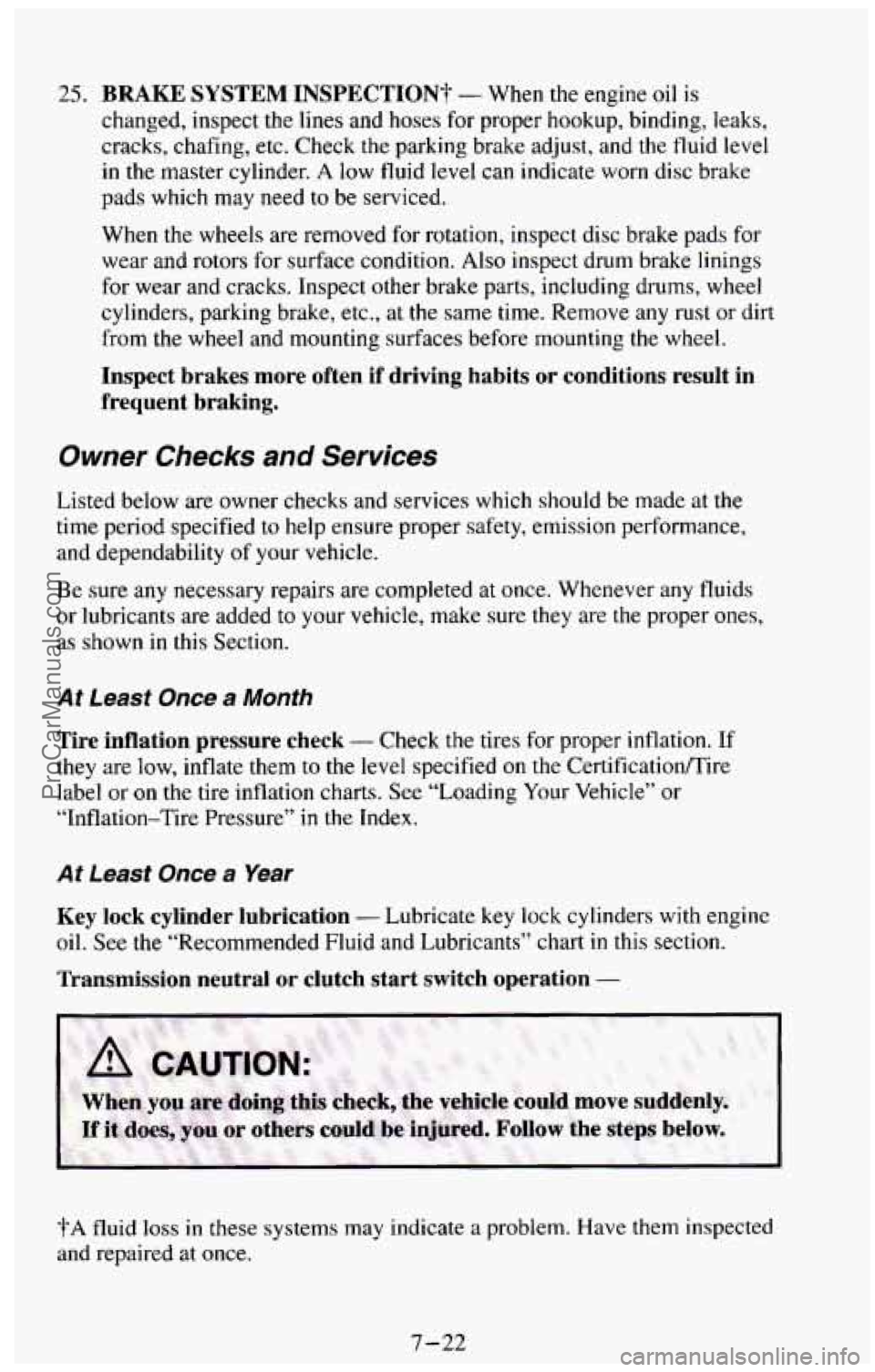
25. BRAKE SYSTEM INSPECTION? - When the engine oil is
changed, inspect the
lines and hoses for proper hookup, binding, leaks,
cracks, chafing, etc. Check
the parking brake adjust, and the fluid level
in the master cylinder.
A low fluid level can indicate worn disc brake
pads which may need to be serviced.
When the wheels are removed for rotation, inspect disc brake pads for
wear and rotors for surface condition. Also inspect drum brake linings
for wear and cracks. Inspect other brake parts, including drums, wheel
cylinders, parking brake, etc., at
the same time. Remove any rust or dirt
from the wheel and mounting surfaces before mounting
the wheel.
Inspect brakes more often if driving habits or conditions resul\
t in
frequent braking.
Owner Checks and Services
Listed below are owner checks and services which should be made at the
time period specified to help ensure proper safety, emission performance,
and dependability of your vehicle.
Be
sure any necessary repairs are completed at once. Whenever any fluids
or lubricants
are added to your vehicle, make sure they are the proper ones,
as shown in this Section.
At Least Once a Month
Tire inflation pressure check - Check the tires for proper inflation. If
they are low, inflate them to the level specified on the Certificatiomire
label or on the tire inflation charts. See “Loading Your Vehicle” or
“Inflation-Tire Pressure”
in the Index.
At Least Once a Year
Key lock cylinder lubrication - Lubricate key lock cylinders with engine
oil. See the “Recommended Fluid and Lubricants” chart
in this section.
Transmission neutral or clutch start switch operation -
?A fluid loss in these systems may indicate a problem. Have them inspected
and repaired at once.
7-22
ProCarManuals.com
Page 379 of 385
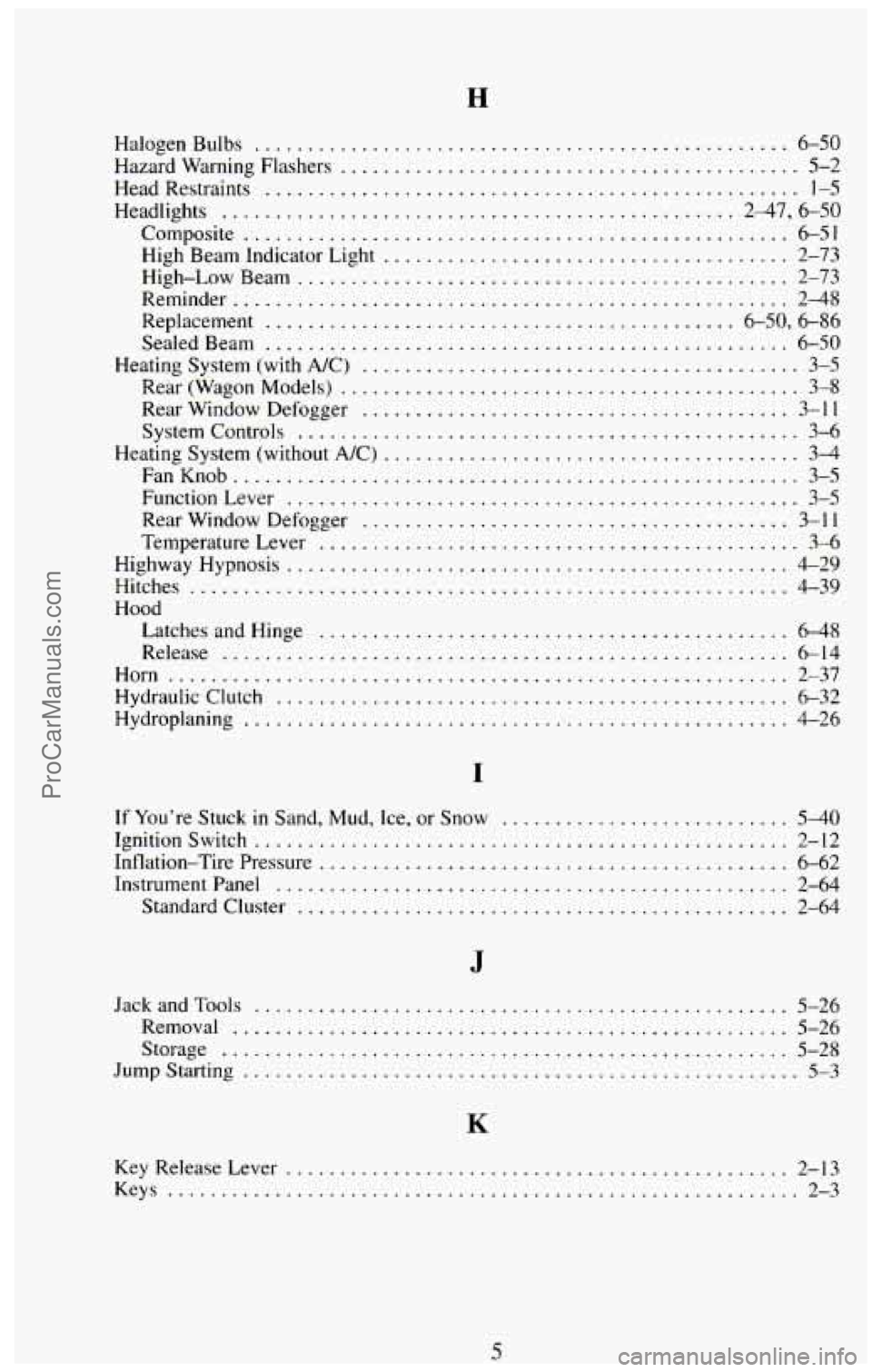
HalogenBulbs .................................................. 6-50
Head Restraints
.................................................. 1-5
Headlights ................................................ 2-47, 6-50
Composite
................................................... 6-51
High Beam Indicator Light
...................................... 2-73
High-LowBeam
.............................................. 2-73
Reminder
.................................................... 2-48
SealedBeam
................................................. 6-50
Heating System
(with NC) ......................................... 3-5
Rear Window Defogger
........................................ 3-11
Heating System (without
AX) ....................................... 3-4
FanKnob
..................................................... 3-5
Function Lever
................................................ 3-5
Rear Window Defogger ........................................ 3-11
Temperature Lever ............................................. 3-6
Hitches
........................................................ 4-39
Hood
LatchesandHinge
............................................ 6-48
Release
..................................................... 6-14
Horn
.......................................................... 2-37
HydraulicClutch
................................................ 6-32
Hydroplaning
................................................... 4-26
Hazard Warning Flashers
........................................... 5-2
Replacement ............................................ 6-50, 6-86
Rear (Wagon Models) ........................................... 3-8
System Controls
............................................... 3-6
Highway Hypnosis
............................................... 4-29
If You’re Stuck in Sand. Mud. Ice. or Snow ........................... 5-40
Ignitionswitch .................................................. 2-12
Inflation-Tire Pressure
............................................ 6-62
Instrumentpanel
................................................ 2-64
Standardcluster
.............................................. 2-64
JackandTools
.................................................. 5-26
Removal
.................................................... 5-26
Storage
..................................................... 5-28
Jump Starting .................................................... 5-3
K
KeyReleaseLever ............................................... 2-13
Keys
......................................................... 2-3
5 ProCarManuals.com